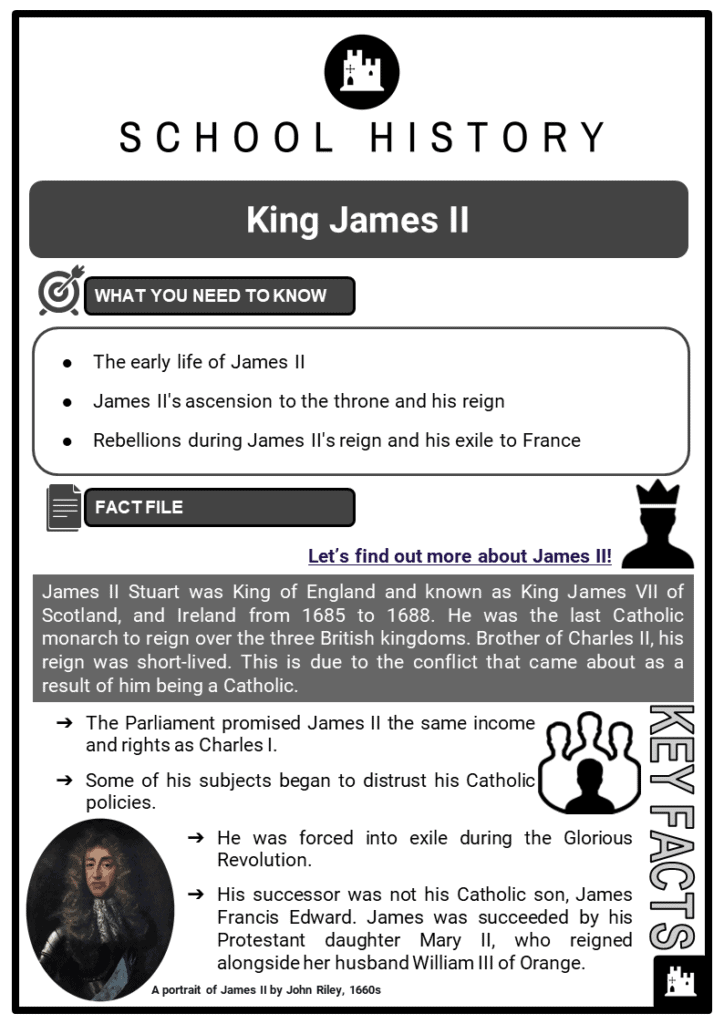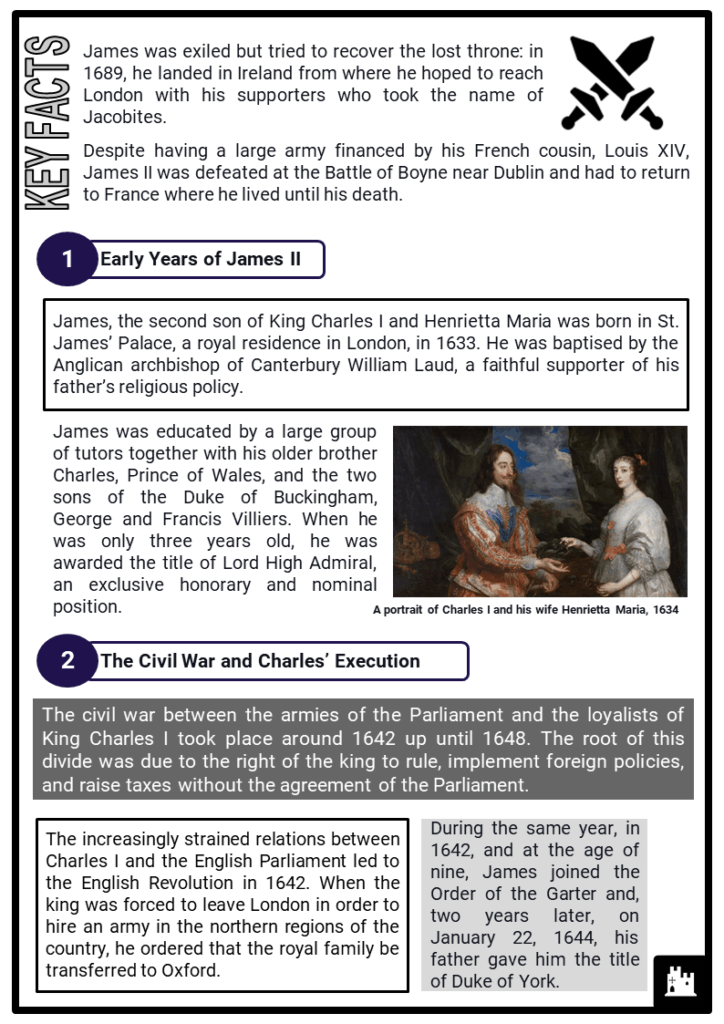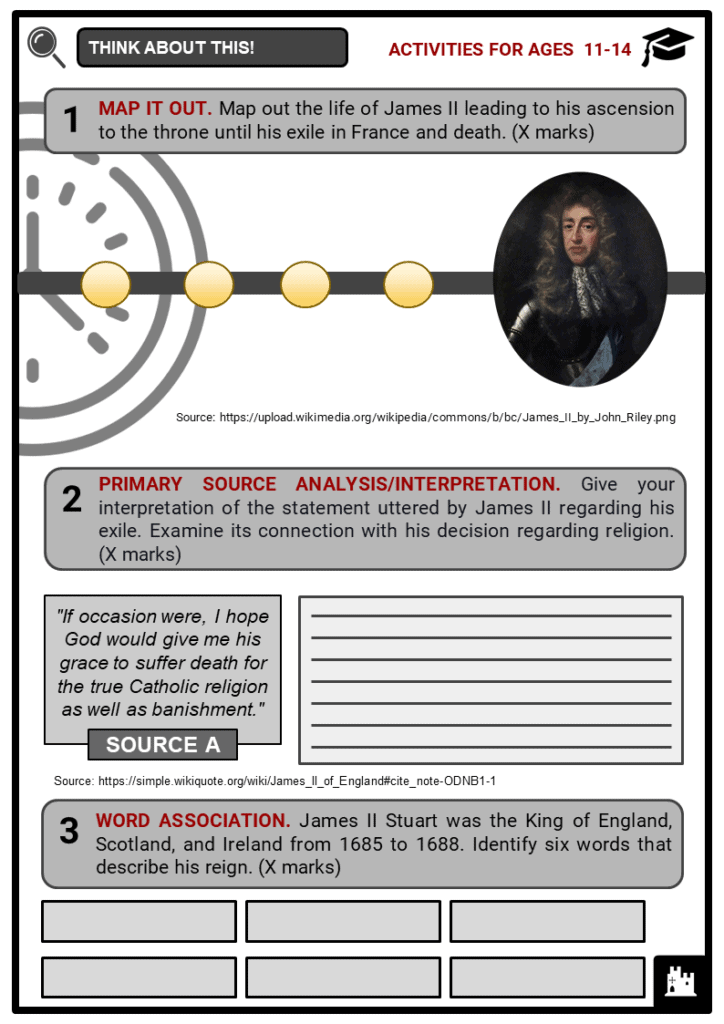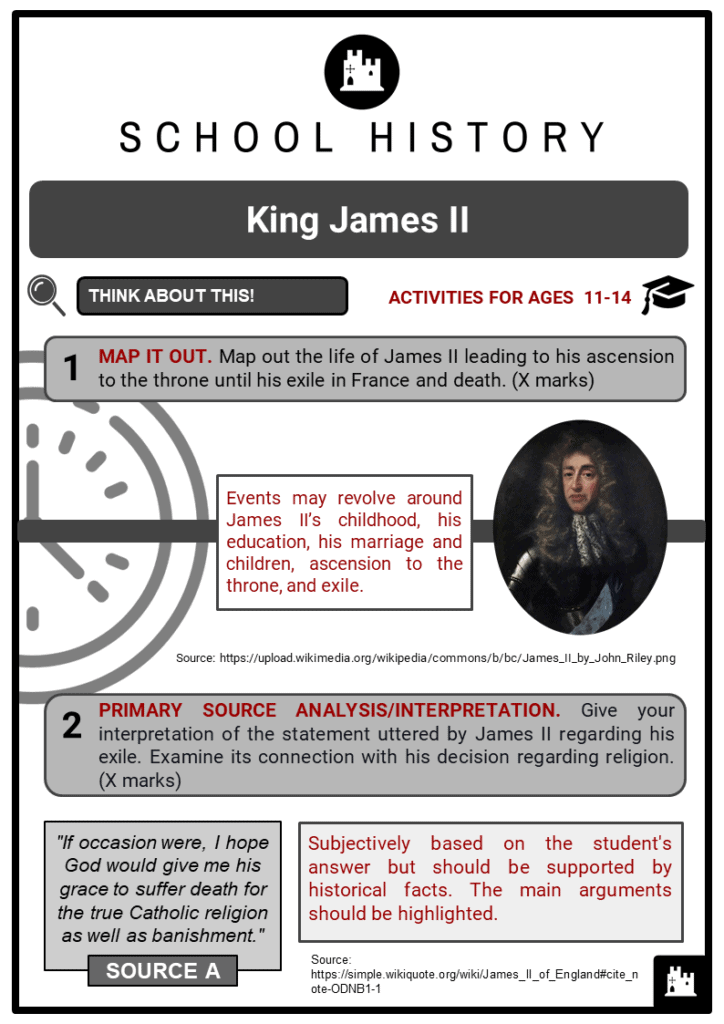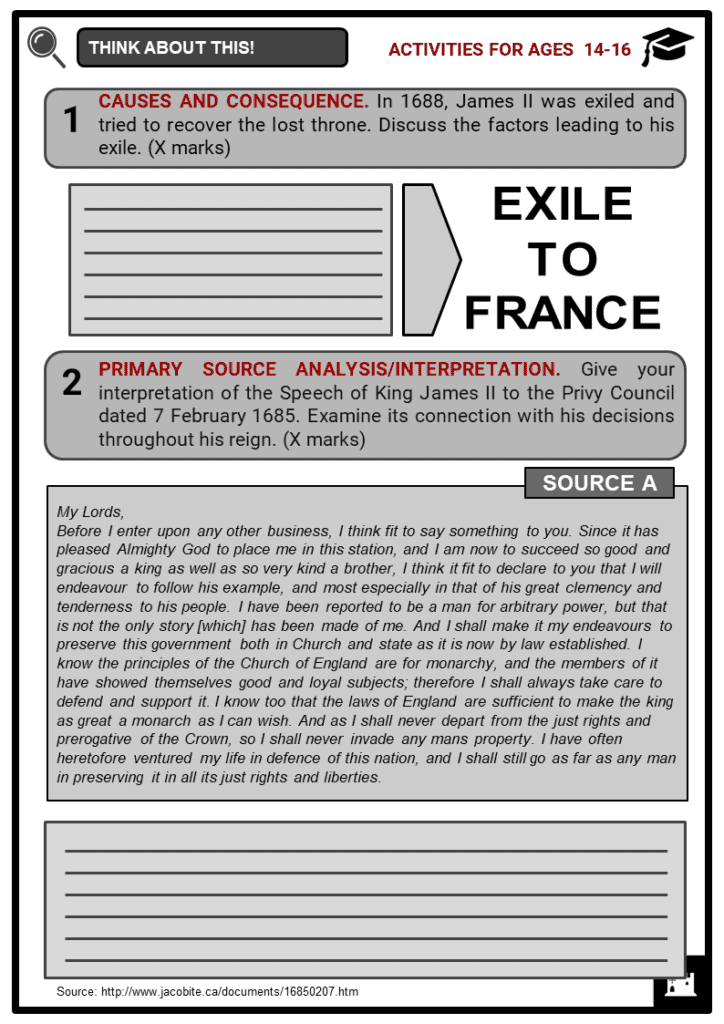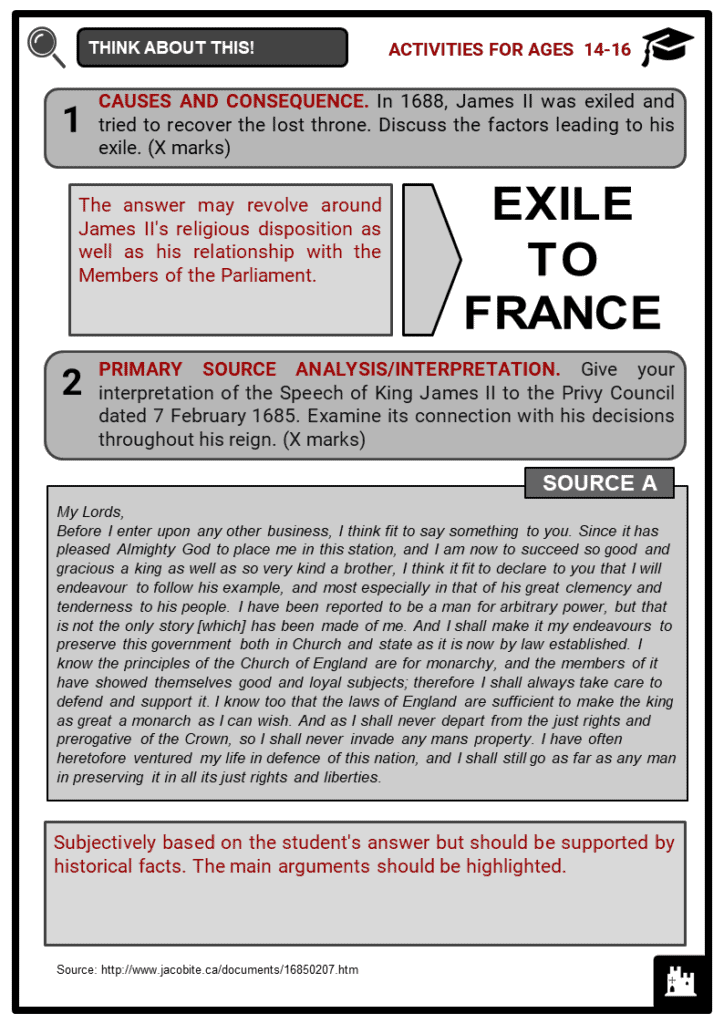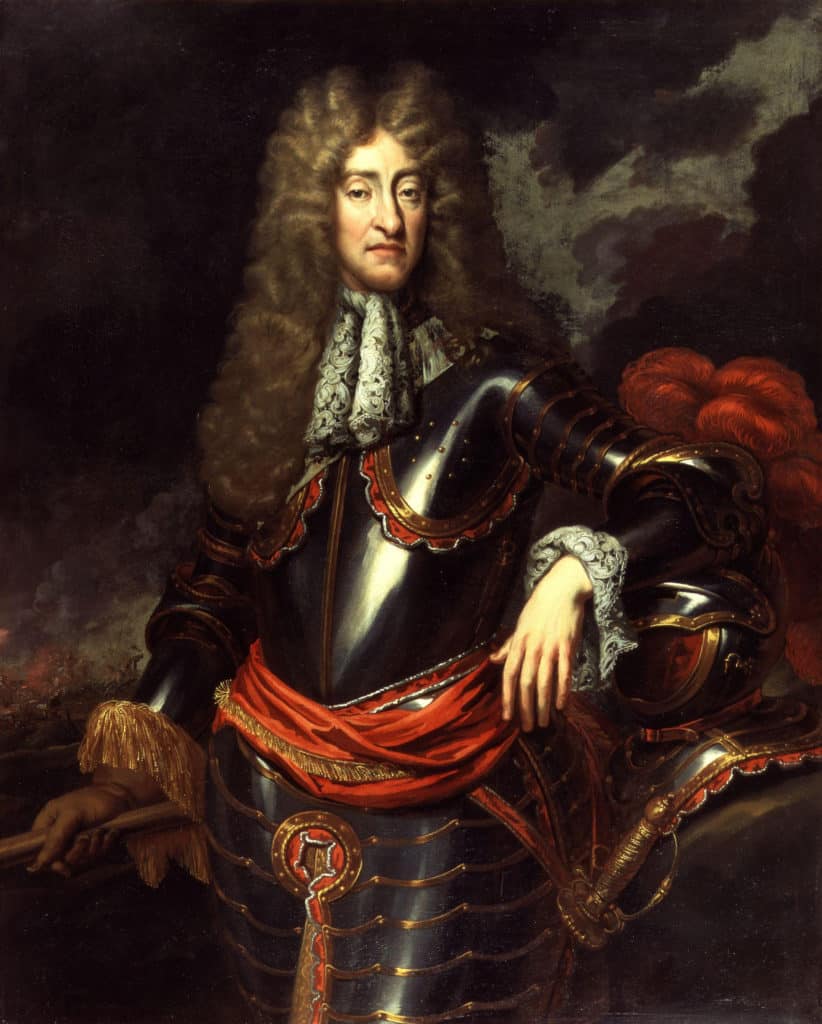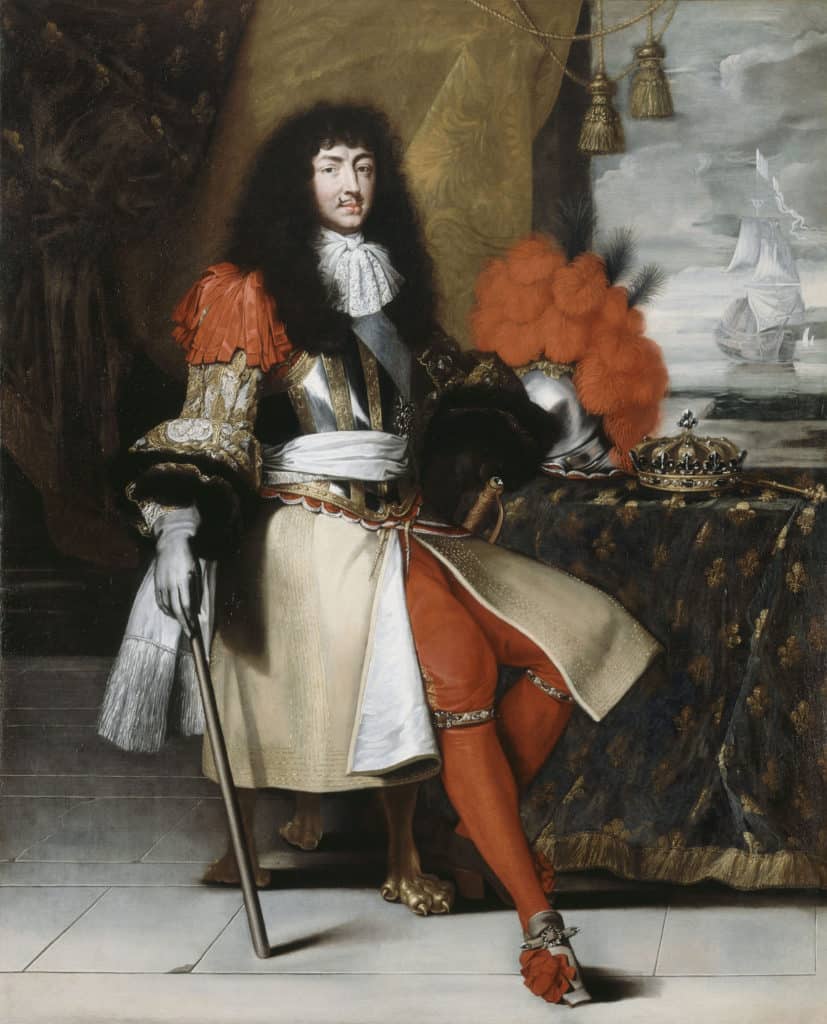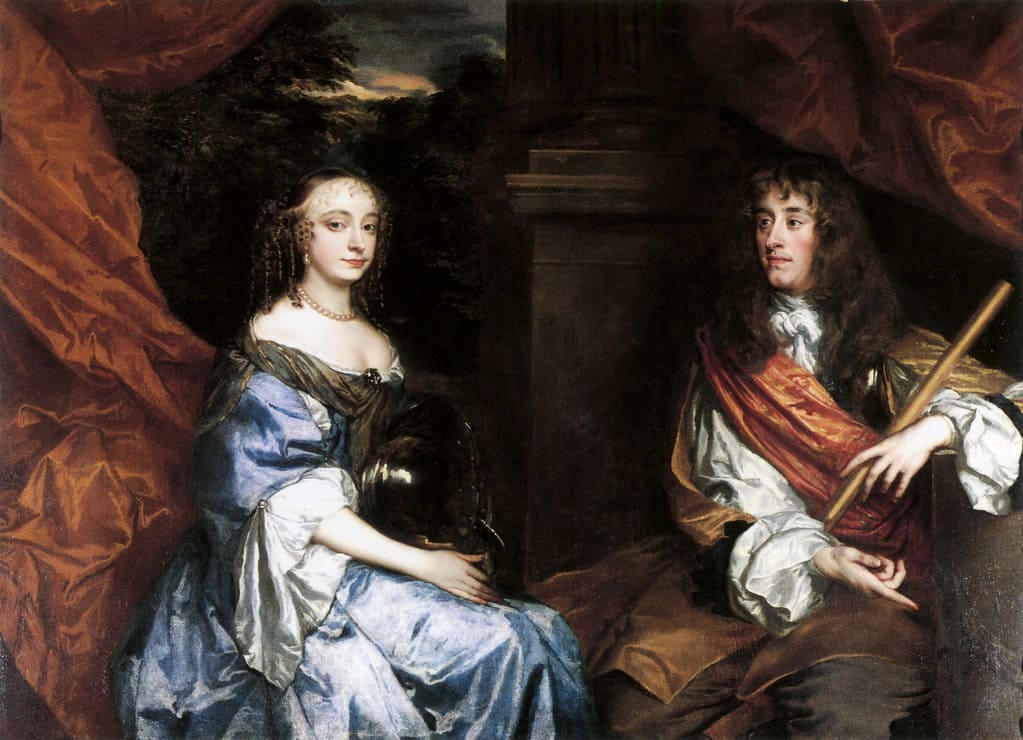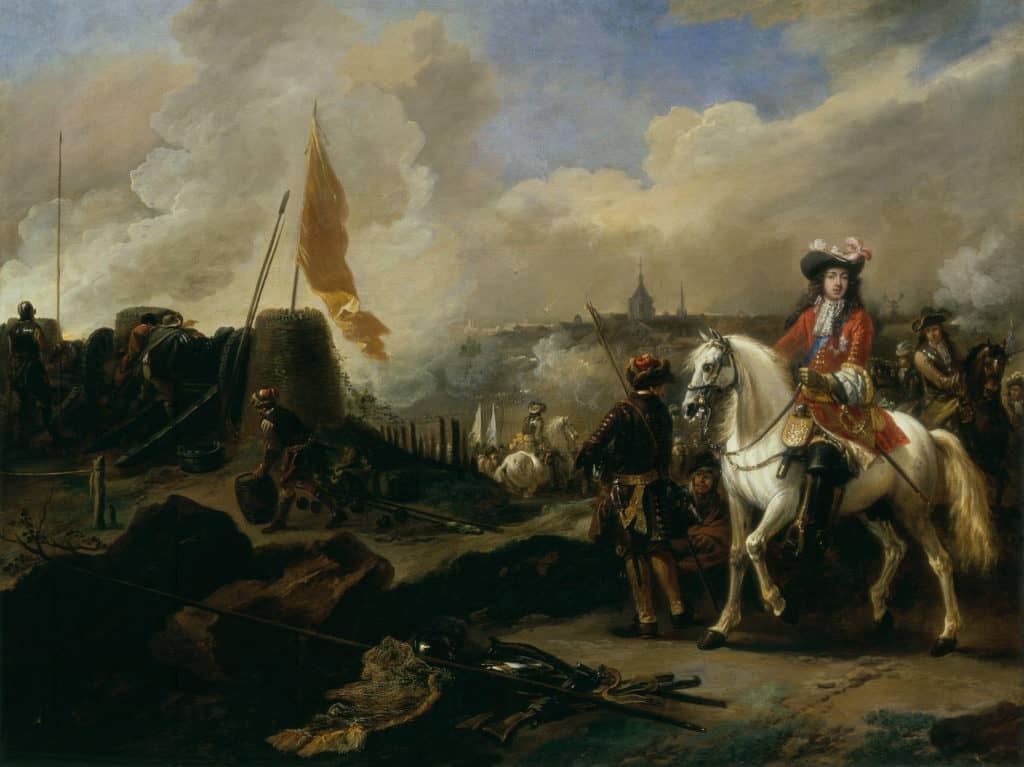Download King James II Worksheets
Do you want to save dozens of hours in time? Get your evenings and weekends back? Be able to teach King James II to your students?
Our worksheet bundle includes a fact file and printable worksheets and student activities. Perfect for both the classroom and homeschooling!
Table of Contents
Add a header to begin generating the table of contents
Summary
- The early life of James II
- James II's ascension to the throne and his reign
- Rebellions during James II's reign and his exile to France
Key Facts And Information
Let’s find out more about James II!
- James II Stuart was King of England and known as King James VII of Scotland, and Ireland from 1685 to 1688. He was the last Catholic monarch to reign over the three British kingdoms. Brother of Charles II, his reign was short-lived. This is due to the conflict that came about as a result of him being a Catholic.
- The Parliament promised James II the same income and rights as Charles I.
- Some of his subjects began to distrust his Catholic policies.
- He was forced into exile during the Glorious Revolution.
- His successor was not his Catholic son, James Francis Edward. James was succeeded by his Protestant daughter Mary II, who reigned alongside her husband William III of Orange.
- James was exiled but tried to recover the lost throne: in 1689, he landed in Ireland from where he hoped to reach London with his supporters who took the name of Jacobites.
- Despite having a large army financed by his French cousin, Louis XIV, James II was defeated at the Battle of Boyne near Dublin and had to return to France where he lived until his death.
Early Years of James II
- James, the second son of King Charles I and Henrietta Maria was born in St. James’ Palace, a royal residence in London, in 1633. He was baptised by the Anglican archbishop of Canterbury William Laud, a faithful supporter of his father’s religious policy.
- James was educated by a large group of tutors together with his older brother Charles, Prince of Wales, and the two sons of the Duke of Buckingham, George and Francis Villiers. When he was only three years old, he was awarded the title of Lord High Admiral, an exclusive honorary and nominal position.
The Civil War and Charles’ Execution
- The civil war between the armies of the Parliament and the loyalists of King Charles I took place around 1642 up until 1648. The root of this divide was due to the right of the king to rule, implement foreign policies, and raise taxes without the agreement of the Parliament.
- The increasingly strained relations between Charles I and the English Parliament led to the English Revolution in 1642. When the king was forced to leave London in order to hire an army in the northern regions of the country, he ordered that the royal family be transferred to Oxford.
- During the same year, in 1642, and at the age of nine, James joined the Order of the Garter and, two years later, on January 22, 1644, his father gave him the title of Duke of York.
- The start of the war led parliamentary soldiers to besiege numerous cities that were loyal to the sovereign, including Oxford itself, which was placed under siege in 1646. Queen Henrietta Maria and heir to the throne Charles had already been sent to Paris, while James, still inside the city, was captured by Parliament troops who brought him back to London. Here, he was confined to St. James’ Palace.
- In January 1649, despite numerous diplomatic attempts made by Charles and James, the British Parliament accused King Charles I of treason and sentenced him to death. While power was effectively in the hands of Oliver Cromwell, supporters of the realist cause nominated Charles II to be king. Charles was recognised by both the Scottish and Irish Parliament and crowned King of Scotland in the city of Scone in 1649. Shortly after, having failed to organise an effective army, he was once again exiled at the French court.
Charles II’s Exile in France
- Just like his mother and older brother, James also went into exile at the court in Paris of his cousin Louis XIV, King of France.
- During this period, the young Duke of York began to devote himself to the art of war where he demonstrated that he was a bold and courageous commander albeit not always valid and brilliant.
- He joined the French army, commanded by General Turenne, who had admiration for the duke. Under Turenne’s command, he fought against the nobles, which threatened the authority of the young French king. In 1653, the rebel princes were finally defeated.
- In 1656, Charles II came into contact with the Spanish court, establishing a friendly alliance with the King of Spain, Philip IV of Habsburg, a traditional adversary of Louis XIV’s France and his Prime Minister, Cardinal Jules Mazarin. This behaviour led to the expulsion of Charles from France, followed shortly after by his brother James, who also left the French army. The two brothers found asylum at the court of Madrid. His stay in Madrid lasted a few months.
- James subsequently moved to Bruges, where his sister Henrietta Maria (Mary), wife of the Dutch Prince William II of Orange, and his younger brother Henry, Duke of Gloucester, welcomed him.
- At Bruges, James joined the Spanish troops under the command of the Prince of Condé and Don Juan of Austria against Turenne’s troops. In the battle of the Dunes, fought between Spain, France, and the United Provinces, James was given the command of a contingent of English soldiers who were loyal to the realist cause. The battle, which ended in disaster for the Spanish troops, led to the signing of a peace treaty between Spain and France. Throughout those years, James met two Irish Catholics, Peter and Richard Talbot, who brought him closer to the Catholic faith.
- Following peace between France and Spain, in 1659 Philip IV offered James the title of admiral of the Spanish fleet. Initially, the Duke of York seriously considered the proposal, given the low probability of a return to his homeland. However, the following year, the situation in London changed: with his brother about to be crowned King of England, James was able to refuse the offer of the Spanish king.
Marriage
- Following Oliver Cromwell’s death in 1658, his son Richard succeeded him. Lacking his father’s experience and charisma, Richard was unable to maintain the power he had obtained and, in 1660, the Commonwealth government collapsed. Richard Cromwell fled and Charles II was able to triumphantly return to London where he was crowned King of England. James was the designated successor to the crown.
- Following his return home, James caused a scandal by announcing his engagement to Anne Hyde, the daughter of Prime Minister Edward Hyde, Earl of Clarendon. In 1659, when both were in exile, James and Anne had promised each other loyalty and the Duke had promised that they would get married.
- In 1660, the same year she returned home, Anne became pregnant but no one in court was in favour of the union between the Duke and Anne. Now visibly pregnant, Anne and the Duke married first in secret then with an official ceremony on September 3, 1660.
- The couple’s first son, Charles, was born about two months later but died in infancy. He was the first of five children who suffered the same fate. The only surviving children were Mary (born on April 30, 1662) and Anne (born on February 6, 1665).
- The chronicler Samuel Pepys wrote that James was very attached to his children and, when around them, abandoned the royal label and behaved with them as an ordinary father. The king’s behaviour was in stark contrast to the traditions of the time, which consisted of being detached and rigid.
- Anne Hyde was devoted to her husband and acted as an important adviser who influenced the king’s decisions. Despite the feeling that the couple had for each other, James had several lovers with whom he had numerous illegitimate children. Among his most famous lovers were Arabella Churchill and Catherine Sedley.
- When Anne Hyde died in 1617, James married a fifteen-year-old Italian Catholic princess, Maria Beatrice d’Este (also known as Mary of Modena) whom he also had children with.
Political and Military Assignments
- After the coronation of Charles II, James became Lord High Admiral, a position supported by the governor of Portsmouth and the Lord Warden of the Cinque Ports. During the second (1665-1667) and the third Anglo-Dutch war (1672-1674), James was placed in command of the English fleet.
- After the Battle of Medway in 1667, in which the English fleet was intercepted and destroyed by the Dutch fleet, James tried to safeguard the coastal fortifications in the south of the country in order to stop the spread of Dutch power.
- In 1664, the British army conquered the New Netherlands (the Dutch territory in America) and renamed it the Province of New York in homage to James, Duke of York. Even the city of New Amsterdam had its name changed to New York in honour of James.
- In 1683, James was appointed governor of the Hudson Bay Company. He played a leading role in the direction of the Royal African Company, which dealt with the African slave trade.
De Facto to the throne of England and Rebellions
- When Charles II died in February 1685, the throne was assigned to his brother, the Duke of York. James was 52 years old when he became King of England, Scotland and Ireland. Being an expert in both military and political fields, he was well received by Parliament and acclaimed by the people.
- On April 23, 1685, James was solemnly crowned at Westminster Abbey. He took the name of James II as King of England and Ireland, and of James VII as King of Scotland.
- In May, the new Parliament proved favourable to the sovereign and assigned to James the same income as his predecessor. The king’s most trusted adviser was the Count of Sunderland.
- James II soon faced a rebellion that became known as the Monmouth rebellion. The Whig Party members who had organised a conspiracy to assassinate King Charles and James had been exiled in the Netherlands. Among them, the two most important figures were James Scott, Duke of Monmouth, the illegitimate son of Charles II, and Archibald Campbell, the Count of Argyll.
- The group of rebels were unbalanced and badly organised: they believed that the right time to strike was when James became king.
- They took six months to organise their forces, however, and decided that the attack would be divided into two parts: one, commanded by Argyll, would act in Scotland (where they could count on the support of Campbell’s clan); the other, led by Monmouth, would have begun its march on London from the western area of the kingdom.
- The Argyll expedition was short-lived: the count was captured in the small Scottish village of Inchinnan on June 18, 1685. He was taken prisoner near Edinburgh and sentenced to death for treason on June 30.
- Monmouth, on the other hand, landed in the Puritan city of Lyme on June 11. He quickly recruited over 4000 artisans and farmers and, a few days later, proclaimed himself king. The Duke’s army fought against the royal army composed of local militias led by John Churchill and the Duke of Grafton. However, the Duke of Monmouth was captured and taken to London where he pleaded in vain to his uncle for his life.
- James II sentenced Monmouth to death and was executed on July 15 inside the Tower of London. Over 300 of Monmouth’s supporters were executed and about 100 were deported to the West Indies.
Religious Policy
- James created an army in order to protect himself from further rebellions. This caused numerous controversies since it was against English tradition to keep an army in times of peace.
- Believing that he had secured Parliament’s favour with the repression of the riots, he asked that the Test Acts (which prevented religious freedom) be repealed. Parliament rejected the king’s request. The king did not respect Parliament’s decision, however, and in 1686 he elected 250 Catholic judges.
- James also sent an ambassador to the Holy See and welcomed the papal nuncio Ferdinando d’Adda. Moreover, he reintroduced Catholic rectors in Cambridge, Oxford, and in Magdalen College, where the entire academic senate was also dismissed.
- James II tried to appease the discontent of the Anglican bishops, who refused to follow the king’s directives. Thus, James created a commission for ecclesiastical causes. Meanwhile, the king had become friends with William Penn, the Quaker founder of the Pennsylvania colony in North America. An exponent of a religious faith persecuted as much as Catholicism, Penn urged James to promulgate a Declaration of Indulgence, with which religious freedom was proclaimed in the kingdom.
The Years of Exile
- In late 1688, MPs led a rebellion against James II, known as the Glorious Revolution. At the end of the revolution, James lived at the court of Louis XIV in Paris.
- Meanwhile, William III of Orange had acquired the throne. James struggled with accepting this. In March 1689, James II landed in Ireland and shortly after his settlement in Dublin controlled almost the entire island.
- William and James’ army engaged in a number of battles. William decided not to kill James, since he was his father-in-law, and allowed him to flee back to France. James II died of a cerebral haemorrhage in 1701 at Saint-Germain-en-Laye, where he was buried.
Image sources:
[1.] https://upload.wikimedia.org/wikipedia/commons/1/14/King_James_II_from_NPG.jpg
[3.] https://live.staticflickr.com/2616/3862433144_2ee17d060a_b.jpg

